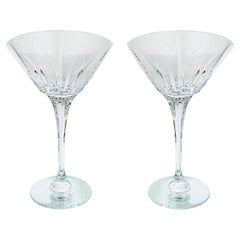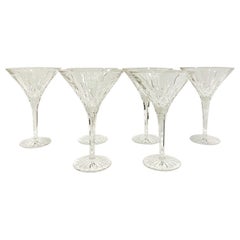Vintage Waterford Martini Glasses
Recent Sales
1990s German Regency Vintage Waterford Martini Glasses
Crystal
1990s German Regency Vintage Waterford Martini Glasses
Crystal
Waterford Crystal for sale on 1stDibs
Among glassware aficionados, the name Waterford has earned a place of eminence — both for antique crystal vases, glasses, chandeliers and serveware made by the original Irish company in the 18th and 19th centuries, and for new versions of the firm’s classic patterns produced after its rebirth in the 1940s. With either iteration, Waterford is a byword for traditional elegance.
Waterford crystal was born of a tax loophole. In 1783, business-minded brothers George and William Penrose founded the Waterford Glass House in southeastern Ireland because Irish glass was exempt from steep British import duties. The two wanted to make fine-quality wares and hired artisans from England, including master glassmaker John Hill. The factory’s flint glass — a precursor to lead crystal — soon won a clientele among British and continental aristocrats.
One of Hill’s aesthetic innovations was to polish glassware after a pattern was cut, to buff off the resulting frosted surface. The look became a Waterford trademark. Through the fame of its wine goblets, claret jugs and decanters, the firm continued to win honors at the many industrial expositions of the early Victorian era. But over those years, higher and higher luxury excise taxes were placed on fine crystal. Waterford products became prohibitively expensive, and the company closed in 1851.
The brand’s renown was still intact when it was revived in 1947 by a Czech glass manufacturer named Charles Bacik, who moved to Ireland after the Communist takeover of his country. For centuries, the region now called the Czech Republic had been the great glassware center of Middle Europe — the source of crystal to legendary Viennese glass design firms such as Lobmeyr and Bakalowits. So Bacik brought with him the master glassblower and designer Miroslav Havel.
In Dublin, Havel studied the old Waterford style book archives kept in the National Museum. He used these classic patterns as the basis for new ones such as Lismore, with its crosshatching and flame-like vertical cuts, and Alana, with its heavily textured diamond cuts. Past and present are thus linked at Waterford.
Introduced in 1991, the Marquis by Waterford range of vases, bowls and other wares were priced for everyday use and were intended for use in modern homes. It was the first new brand debuted by the company in what was then its more than two-century history.
As you will see on 1stDibs, antique or recently made, Waterford crystal is the essence of refinement.
Find Waterford crystal vases, serveware and other collectibles for sale on 1stDibs.
A Close Look at Regency Furniture
Like France’s Empire style, Regency-style furniture was rooted in neoclassicism; the characteristics of its bedroom furniture, armchairs, dining room tables and other items include clean lines, angular shapes and elegant details.
Dating roughly from the 1790s to 1830s, antique Regency-style furniture gets its name from Prince George of Wales — formally King George IV — who became Prince Regent in 1811 after his father, George III, was declared unfit to rule. England’s Regency style is one of the styles represented in Georgian furniture.
George IV’s arts patronage significantly influenced the development of the Regency style, such as the architectural projects under John Nash, which included the renovation of Buckingham House into the formidable Buckingham Palace with a grand neoclassical facade. Celebrated designers of the period include Thomas Sheraton, Henry Holland and Thomas Hope. Like Nash, Hope instilled his work with classical influences, such as saber-legged chairs based on the ancient Greek klismos. He is credited with introducing the term “interior decoration” to English with the 1807 publishing of Household Furniture and Interior Decoration.
Although more subdued than previous styles like Rococo and Baroque, Regency interiors incorporated copious use of chintz fabrics and wallpaper adorned in chinoiserie-style art. Its furniture featured fine materials and luxurious embellishments. Furniture maker George Bullock, for instance, regularly used detailed wood marquetry and metal ornaments on his pieces.
Archaeological discoveries in Egypt and Greece informed Regency-era details, such as carved scrollwork, sphinxes and palmettes, as well as the shape of furniture. A Roman marble cinerary chest, for example, would be reinterpreted into a wooden cabinet. The Napoleonic Wars also inspired furniture, with martial designs like tented beds and camp-style chairs becoming popular. While the reddish-brown mahogany was prominent in this range of pieces, imported woods like zebrawood and ebony were increasingly in demand.
Find a collection of antique Regency tables, seating, decorative objects and other furniture on 1stDibs.
Finding the Right Barware for You
Whether it’s streamlined or sophisticated, a bar area is always a welcoming feature in any home interior. A cheery well-made drink with friends and family has the potential to yield some unforgettable moments alongside those that aren’t easily remembered. And the only way to conjure that exemplary cordial is by putting the proper antique or vintage barware to work.
Essential barware equipment ranges from sterling-silver barspoons for mixing your cocktails in tall collins glasses to jiggers, shakers and strainers that allow you to whip up martinis and old-fashioneds.
From a design standpoint, some barware, such as our array of Art Deco glass whiskey sets or mid-century modern silver-banded tumblers crafted by Dorothy Thorpe, can help position your bar as a bold and attractive centerpiece to a room. At the very least, a carefully curated collection of barware can elevate with subtlety the bar’s nearby fixtures, as a handcrafted crystal decanter might do for your vintage 1960s bar cart.
As cocktail hour draws near, find inspiration in our gorgeous gallery of home bars in locales ranging from London to New York to San Francisco, and browse the exquisite selection of antique, new and vintage barware and glassware on 1stDibs.
- 1stDibs ExpertNovember 26, 2024To identify Waterford glass, use its acid markings. You may need to use a magnifying glass while holding your piece up to the light to read them. Waterford began using acid marks in 1950 and has marked pieces with Gothic lettering, script word marks and its seahorse logo over the years. Older pieces usually had foil labels, which may have come off over the years. If your piece is unmarked, a certified appraiser or experienced antique dealer can help you determine if it's a Waterford. Find a wide range of Waterford glassware on 1stDibs.

